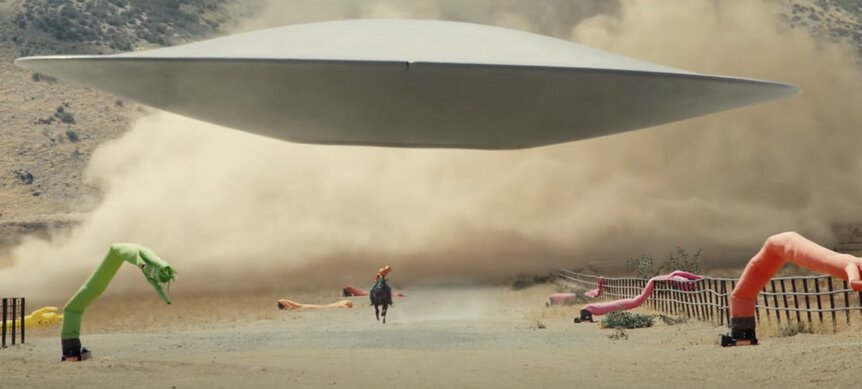Create a free profile to get unlimited access to exclusive videos, sweepstakes, and more!
‘Nope’ editor reveals details from those sitcom flashbacks you might have missed
SYFY WIRE interviewed Nope editor Nicholas Monsour about his work shaping Jordan Peele's epic sci-fi thriller.

Jordan Peele’s epic film, Nope, brings both extraterrestrial spectacles and intimate moments to the big screen. It’s a movie that was made to be seen in the theaters, and one that seamlessly moves between the epic and the personal, and intermixes the horrors of the present day with the traumas of the past.
Editor Nicholas Monsour worked with Peele and the rest of the creative team to bring the world of Nope to life. In an interview with SYFY WIRE, Monsour shared his experience working on the UFO horror thriller. Read on to find out when Peele decided to move forward with Nope as well as some details from a pivotal moment in the movie you might have missed.
Warning! Spoilers for Nope lie below.
“My understanding of the way Jordan works … is that he's got seeds for a lot of ideas,” Monsour told SYFY WIRE. “I don't know when they formed — they may have formed when he was a kid watching movies, they may be brand new, popping into his head all the time, but he's got the seeds.”
According to Monsour, the COVID lockdown germinated the seeds for Nope, partly because Peele wanted to make a movie that would bring people back to the theater. “The core idea — the horse ranch, this brother and sister encountering the UFO and the attempt to capture that on film — was there from pretty much the first time I heard him mention anything about it, before he'd even written it,” Monsour said.
(As for other seeds found in Nope, a 2014 Tweet from Peele suggests that the whole chimpanzee storyline came from a dream he had where he woke up crying.)
One thing Nope does so well is how it moves the audience from expansive shots of the UFO moving through the sky to the characters cowering in their home or a stable shed. “The number one way I know that I feel drawn into a film, especially a thriller or horror scenario, is when I really feel linked to the characters’ experience of the events,” Monsour explained. “And so a lot of the interiors in the house and the sound design are really focused on feeling like you're in there with them, rather than having a God's eye view of everything that's happening.”
Nope also uses flashbacks, particularly those involving Ricky “Jupe” Park’s (Steven Yeun), to develop its characters, convey themes, and bring tension to the story. For Jupe, we get to see the whole bloody sitcom sequence with the chimpanzee unfold at one point in the film, but we also get quick cuts of young Jupe, scared and bloody on the sitcom set, at key moments, such as when Jupe is about to open his first family show featuring the UFO. (A debut that goes horribly, horribly wrong.)
“You can tell how intentional it is,” Monsour said about those quick cuts to young Jupe. “The lighting, the production design, the angle on the young actor playing young Ricky Jupe … even down to the color of the curtains behind present-day Jupe and the color of the tablecloth behind young Jupe and their placement in the frame. It's all very intentionally matched so that you feel this blur of how that little scared kid who experienced that trauma is still in that guy.”
Making sure these details line up is only part of what makes Monsour’s job so fulfilling. “The edit is a really fun place to be,” he said. “It's the place I really enjoy being because it's where we get the raw version of everything … we can do some raw musical work, some raw sound work, some raw visual effects work, and find the rough sketch which then gets finished.”
You can currently see the finished Nope, in all is terrifying glory, in theaters.



























